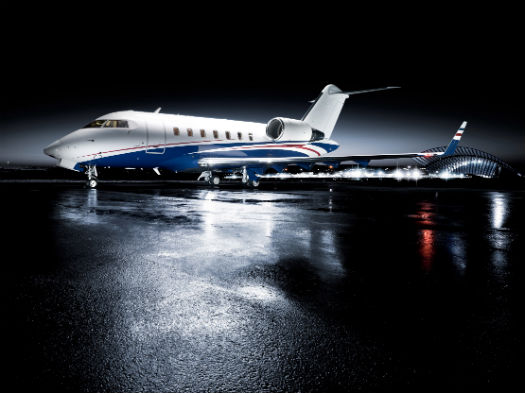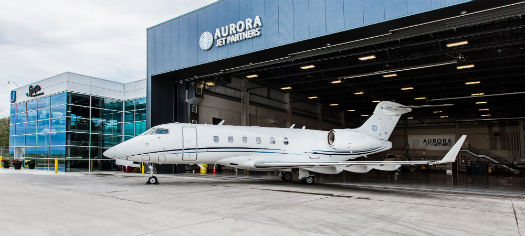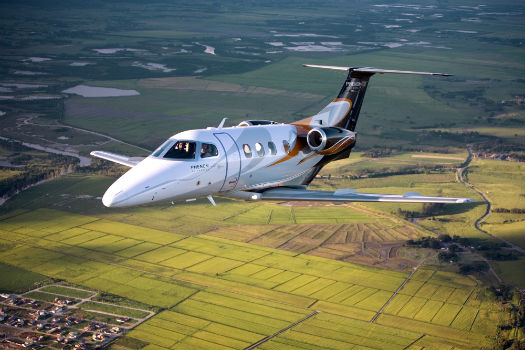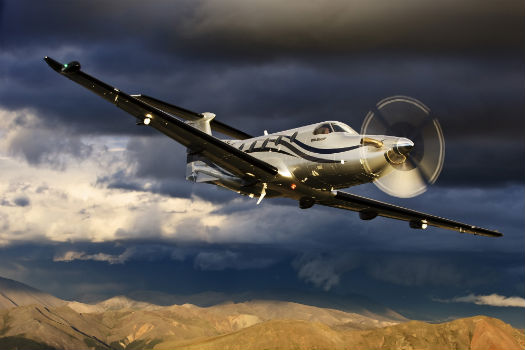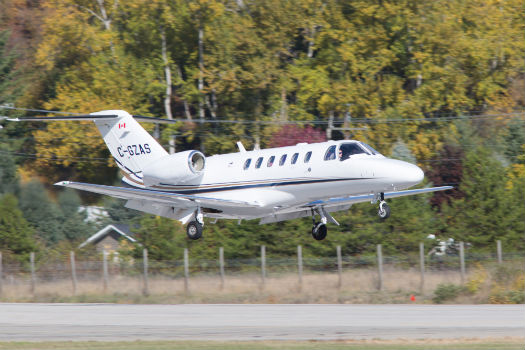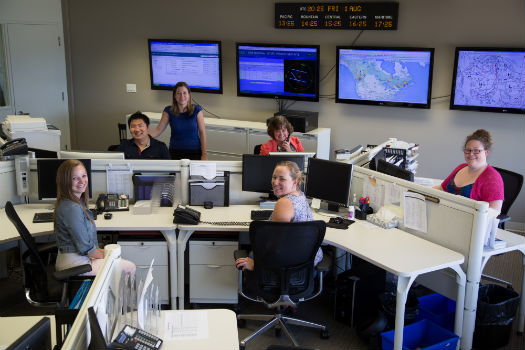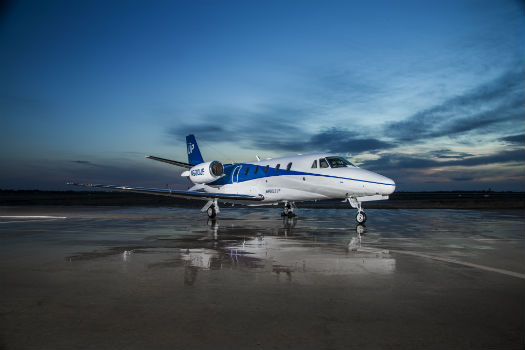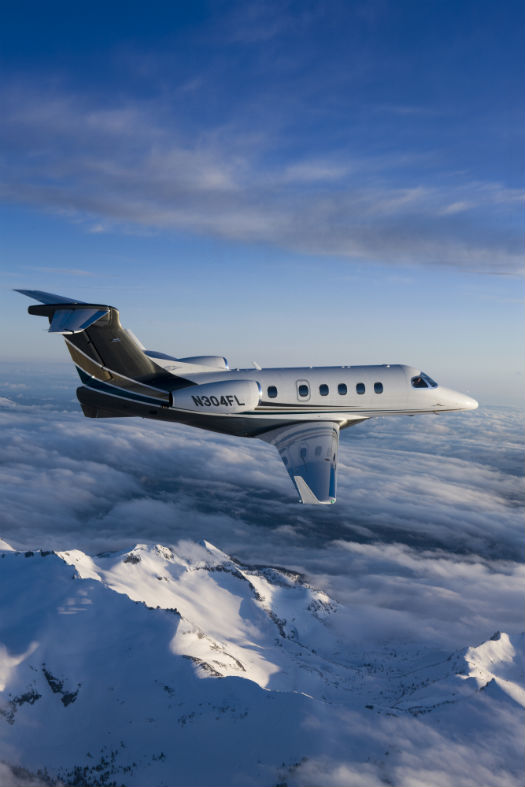In the U.S., Flexjet LLC operates as a luxury “bespoke” service, flying newer
aircraft (four years old or less). The fractional provider was previously owned by
Bombardier, but was purchased by Directional Aviation in December 2013. Flexjet Photo
When the U.S. economy went off the rails six years ago, the business and private jet fractional ownership industry in Canada and the U.S. went along with it. Some companies survived, and some did not. Today, the industry seems to be recovering, despite the disappearance of a number of players. Canadian fractional operators AirSprint Private Aviation, Aurora Jet Partners and Jet-Share Aviation are dominant north of the border and growing. In the U.S., major players in the fractional market include Executive Air Share, Flexjet, Flight Options, NetJets, and PlaneSense.
In Canada, AirSprint opened its doors in 2000 with a small fleet of Pilatus PC-12 single-engine turboprop aircraft, and has grown steadily. The transition to an all-jet fleet was completed in July 2014, and the company now operates 14 aircraft—a mix of Citation XLS and Citation CJ2+ light jets. AirSprint has orders for an additional nine Citations, said its chief operating officer, James Elian. And, he added, “We are considering expansion into larger aircraft, although there’s nothing definitive at this time.”
Aurora Jet Partners of Edmonton, Alta., has tripled in size since the recent
economic downturn. Aurora Photo
AirSprint, with 130 employees (slightly more than half of whom are pilots), is headquartered in Calgary, Alta., with locations in Vancouver, B.C.; Montreal, Que.; Edmonton, Alta.; and Toronto, Ont. The cost structure is relatively simple and fairly typical of fractional ownership programs. For a 1/16th share and 50 hours a year in the Citation CJ2+, AirSprint charges a one-time share purchase price of C$492,570 (US$451,079). Monthly management fees are $9,000 (US$8,241), with variable fees per occupied flight hour of $1,750 (US$1,602). The company also has a lease plan that includes 50 flight hours a year in the CJ2+ with no purchase price (known as the no-capital option). That program does include a $1,750 (US$1,602) variable fee for occupied hours and a monthly fee of $13,400 (US$12,271).
With total membership shares now slightly over 100, AirSprint is meeting its passengers’ growing demand for the latest cabin amenities. Satellite phone and cabin WiFi connectivity are standard across the fleet, interfacing with all laptops, tablets and smartphone brands. With each flight, AirSprint also provides one iPad which contains the latest newspapers, movies, music and books. There are no cabin video screens; however, the XLS fleet has a cabin flight information screen and the Citation CJ fleet will have a WiFi link to an online flight tracking website that is pre-set on each iPad.
Embraer’s Phenom 100 is a popular light jet often found in the fleets of fractional
ownership providers. Aurora Photo
While Elian admitted the recent recession was tough, he said the company “remained profitable.” And with a recovery underway, he said revenues from 2012 to 2013 were up 20 per cent, and revenues for the first two quarters of 2014 suggest more of the same.
The recession had roughly half the impact on business aviation in Canada as it did in the U.S., probably because the Canadian economy remained healthier, pointed out Elian. However, he added, “A number of fractional providers in Canada and the U.S. prior to the recession were relying on share sales to achieve profitability, and those companies were the hardest hit when demand dropped.”
Aurora Jet Partners of Edmonton is also enjoying a healthy growth spurt these days, tripling in size since the recession. It offers a broad range of aircraft from the large-cabin, ultra-long-range Bombardier Global 5000 to the Embraer Phenom 100 light jet. According to Aurora president Bill McGoey, partners benefit from the varied fleet. For example, someone with a share in a smaller aircraft can occasionally move to a larger airplane, if it’s required by the mission. “You buy into one airplane, and have use of the entire fleet,” he told Skies.
Executive AirShare reports that profits and flight hours are up, and it has now
enrolled more than 145 fractional owners. Executive AirShare Photo
Aurora plans to add five aircraft in 2015. All existing shares are sold out except for one in a Phenom 300. “We don’t firm up the order until an aircraft is at least three-quarters sold,” explained McGoey. “At that point, we push the button and accept delivery.”
The traditional fractional program business model takes into consideration a manufacturer wholesale discount for volume orders and adds a retail markup per share to make a small “spread” on each share, “but that share is not what it used to be,” said McGoey.
He emphasized that to be successful in the fractional market, any opportunity must be considered. “We would love to align ourselves with another aircraft management company in Eastern Canada that would allow an interchange of aircraft and create new efficiencies, allowing owners to benefit from a larger aircraft pool,” he said. The move may require regulatory approval from Transport Canada and the Canadian Transportation Agency, and McGoey said the company is investigating a number of possibilities.
Nicholas Air of Columbus, Miss., plans to acquire more Pilatus PC-12 NGs
(shown here) and Embraer Phenom 300s. Nicholas Air Photo
Jet-Share Aviation is a small but successful fractional operation in Mississauga, Ont. The fleet consists of four airplanes–—three Citation business jets and a King Air C90B.
Company president Michael Bannock said the key to the fractional program’s success is that he only offers one-third shares. “With the numbers I have, less or more than a one-third share is not efficient,” he explained. Bannock also said his market base is composed of customers who are flying 200 to 250 hours a year, “for which fractional ownership makes sense, both for them and for us.”
He also does not buy new aircraft. “The real value is in pre-owned airplanes,” he declared. And, he prefers to purchase through an OEM asset management group, which allows him the option of manufacturer support and service programs at a more reasonable cost. The next addition to the fleet will be a King Air 350 twin-turboprop, for which Jet-Share already has a lead client, reported Bannock.
The giant of fractional ownership programs, Ohio-based NetJets, was founded in 1964 under the name Executive Jet Aviation. In 1984, the company was purchased by Richard Santulli, who is rightfully described as the father of the aircraft fractional ownership concept. Right-sized in recent years to meet changing demand, the company fleet now totals some 700 airplanes worldwide and represents 14 per cent of all private jet takeoffs and landings in North America. That number is on the rise, said NetJets head of U.S. sales, Pat Gallagher.
AirSprint opened its doors in 2000 with a small fleet of Pilatus PC-12
single-engine turboprops. Today, its all-jet fleet includes a mix of Citation XLS
and Citation CJ2+ light jets. AirSprint Photo
In late June 2014, NetJets took delivery of Bombardier’s first Challenger 350. In 2010, it had placed orders with several manufacturers for as many as 670 new business jets, with a total value of US$17.6 billion. All of the highly customized aircraft are part of NetJets’ new Signature Series, and to date the program has taken delivery of 42 of the new models, including a 15-aircraft mix of Bombardier Global 5000s and Global 6000s.
The company’s latest expansion established NetJets China, a joint venture with a consortium of Chinese investors. An operating certificate was received from the Civil Aviation Administration of China and NetJets China began flight operations in August this year.
Gallagher emphasized the necessity of equipping the cabin to meet the expectations of the customer base. “I would say for the industry as a whole, the cabin is most important [and] that is what differentiates the Signature Series,” he commented.
“We worked with manufacturers on the Signature Series to provide exactly what our customers want—sound damping, humidification, better equipped galleys, cabin WiFi connectivity, an aft section in the Global 6000 that converts to a private stateroom, and lavatories forward and aft,” he said.
AirSprint, with 130 employees (slightly more than half of whom are pilots),
is headquartered in Calgary, Alta. AirSprint Photo
Meanwhile, in December 2013, U.S. fractional operator Flexjet was acquired by Directional Aviation, which purchased the company from Bombardier for US$195 million. The deal’s closing confirmed major aircraft orders from Flexjet, including 115 business aircraft, with an additional 150 options. If all options are exercised, the total value of the order is expected to be about US$5.6 billion (based on 2013 prices).
Included in the list of firm Flexjet orders are 60 Learjet 85 aircraft, valued at US$1.2 billion. “After reviewing our long-term fleet strategy and listening to customer needs, we believe the Learjet 85 aircraft will be a distinct competitive advantage and an important contributor to our future growth,” said Directional Aviation principal, Ken Ricci.
Initially, Flexjet seemed to be an unlikely candidate for acquisition by the Directional Aviation portfolio, which already owned Flight Options. However, Flexjet and Flight Options were positioned to complement each other within the portfolio, rather than competing against one another. At the time, Ricci explained that Flexjet LLC (formed by Directional Aviation for the acquisition) would operate separately as a luxury “bespoke” service, flying newer aircraft (four years old or less). Flight Options was to provide value with a fleet of mostly pre-owned or remanufactured jets. In essence, both are focused on the same markets as before the acquisition.
The current fleet at PlaneSense is exclusively comprised of single-engine
turboprop Pilatus PC-12 NGs. However, the company recently placed an order
for six new Pilatus PC-24 jets. PlaneSense Photo
“This market has come to understand the inherent value of fractional shares in a pre-owned aircraft,” said Ricci. “In competitive new aircraft fractional programs, you pay retail sticker price for your share, even though the airplane that picks you up may have 600, 1,000, 2,000 or more flight hours. That’s pre-owned by any definition. Our program clearly gives the owner what they pay for.”
Flight Options, based in Cleveland, Ohio, has over 1,300 owners and boasts a fleet of more than 100 aircraft, ranging from the large-cabin Embraer Legacy 600 to the Embraer Phenom 300 super light jet. With aircraft available in as little as 10 hours’ notice, Flight Options flies owners all over North America and as far away as Europe.
PlaneSense is unique in that its fleet consists exclusively of the Pilatus PC-12 single-engine turboprop aircraft. But, that will be changing. The Portsmouth, N.H.-based fractional took receipt of its 50th PC-12 on May 17, 2014; and just three days later, announced the largest launch order with Pilatus Business Aircraft for six new PC-24s, the Swiss manufacturer’s first jet.
The Wheels Up fleet currently includes 20 King Air 350i twin turboprops and
six Citation XL and XLS business jets. The “membership program” currently
has some 600 members. Wheels Up Photo
The six-passenger PC-24 is described by Pilatus as a “super versatile jet” with the cabin size and comfort of a medium/light business jet, the versatility of a turboprop, and the performance of a light business jet. It has a projected range of 1,800 nautical miles with six passengers and a max cruise speed of 425 knots. Certification is expected in 2017 and the first deliveries to PlaneSense should begin shortly thereafter. The airplane, “with its large cabin, exceptional performance and trademark large cargo door, will further enhance our service offering and augment our marketplace reach,” said PlaneSense president and CEO, George Antoniadis.
PlaneSense covers many areas of the continental U.S., the Bahamas and Canada. Antoniadis noted that in the past 18 months, the fractional has conducted more than 400 flights from the U.S. into Canada. “We represent a very, very cost-effective solution for Canadians flying from Eastern Canada and down into the U.S., [and] the PC-12’s performance allows us to fly into Billy Bishop Toronto Airport.”
Fractional operations elsewhere in the U.S. are also growing. Executive AirShare claims it is the nation’s fourth-largest fractional. The company ordered three, six-passenger Citation CJ2+ light jets last year, adding a nine-passenger Learjet 45XR to its fleet in June.
Executive AirShare said profits and flight hours are up, and it has now enrolled more than 145 fractional owners. Most recently, the Kansas City-based fractional announced it had invested approximately $25 million in new aircraft last year, and expects to spend the same amount in 2014.
Flight Options of Cleveland, Ohio, has over 1,300 owners and boasts a fleet of
more than 100 aircraft, available with as little as 10 hours’ notice. FlightOptions Photo
One of the smaller U.S. fractional operations is Nicholas Air in Columbus, Miss. It has recently taken the unusual step of restructuring into larger share segments—specifically one-fourth and one-half, now branded as a “joint ownership program.”
“Having more owners actually diminishes the share value by flying more and more hours, and generating more and more wear and tear,” said company president N. J. Correnti. “The company has options to acquire more PC-12s and Phenom 300s [and] we expect to get into the larger aircraft market, when the time is right.” He added that Nicholas Air has grown between 50 and 80 per cent annually over the past three years.
If there is evidence of the evolution of fractional ownership in the U.S., it seems best reflected in the Wheels Up program under CEO Kenny Dichter, who said the newly-formed company is growing in line with initial projections. The New York City-based “membership” program now has 28 airplanes and some 600 members. “We are on target for meeting and exceeding our business objectives,” commented Dichter.
The Wheels Up fleet currently includes 20 King Air 350i twin turboprops and six Citation XL and XLS business jets. There are also two Global 5000s owned by partner VistaJet and operated by Jet Aviation. Dichter anticipates the fleet will total 27 King Airs, 10 Citation XL and XLS aircraft, and between three and five Globals by the end of 2014.
The personification of confidence and ambition, Dichter expects that by 2016, the Wheels Up program will cover the entire U.S., coast-to-coast, and establish a presence in Canada and Europe.
Fractional ownership in Canada continues to grow, albeit slowly, and certainly more slowly than in the U.S. One reason, said Elian at AirSprint, is the size of the Canadian market. “We have about one-tenth the total population of the U.S., and a smaller market percentage in terms of demand for private jet travel.”
McGoey of Aurora has a similar opinion. “I would say the market is pretty much saturated for fractional start-ups, largely because of demographic and geographic challenges in Canada which require scale,” he commented. “Major economic centres are relatively few and relatively smaller compared with the U.S., and the population distribution is different. We’re necessarily localized because of the overall size of the country.”
While fractional ownership anywhere is not without its risks, Aurora is evidence that it can succeed in Canada. “In that first year, in 2007, and on through 2010, we sold four fractional jets,” remembered McGoey. “But between 2011 and 2013, we tripled in size from four aircraft to 12, growing in revenue, total aircraft, total fractional partners and total employees. And 2014 looks like more of the same.”
A native Virginian, Kirby Harrison retired from the U.S. Navy in 1987 after a 20-year career as a photojournalist. He graduated from Syracuse University in 1991 with a degree in photojournalism and worked for Studio Sebe in France for three years. Since 1992, Kirby has worked as an aviation writer and photographer.
